
'Helping Hands' (inset). Martha Davis, 2022. Mixed media.
WHITNEY SMITH What led you to think of making dioramas in your garden, and how did you get started?
MARTHA DAVIS An innocent childhood is no longer possible. Depressing news is around children all the time and they’re struggling with their mental health. With my dioramas, in my own little way, I am providing a safe place, a mini-forum for kids to open up and begin a dialogue with their parents/guardians on some of the important issues of our times, ones about which they might be confused, wary or fearful. Climate change, habitat loss, food insecurity, the exploitation of our animal friends, loneliness, addiction and our health care in crisis are all explored. I hope to draw kids in by exploring these serious issues with a lighthearted touch, using miniature animals, dolls, and toys in bright coloured environments. And, of course, a sense of humour. The garden lightbox is an ideal setting for this, as parents walk the neighbourhood with their kids in tow and often have a few minutes to stop, view and discuss the scenes unfolding inside.
I’ve been retired from elementary school teaching for five years, but working with kids is still in my bones. This all started when I ran an after school arts enrichment program during the pandemic, and we were “bringing the inside outside” as much as we could. In the summer of 2021 I created Pandaland, a society of toy pandas, with a bunch of neighbourhood kids on public property across the street from my house. As in any society, issues emerged, and after discussion the kids held an election to decide which issue should be solved: provide housing for homeless pandas or clean up their lake.
I was struck by the empathy and compassion they showed after the election and as they made changes to improve life for the pandas. I made a 14 minute documentary film about Pandaland, which I showed in many local classrooms. I think the main message of the film is that when kids get involved and participate, they can make change happen. That goes for us adults, too.
The success of Pandaland in my neighbourhood spurred me on, but I knew I wanted to work smaller — Pandaland was spread out over 15 feet! So I got a 11"x17” light box built and now create a new diorama each week. I’m having an exhibition at a local gallery in May showing photographs of all 20 dioramas plus four or five physical ones. There will be an area where kids can build and photograph their own diorama with materials provided. I’ll be inviting classes from the local schools and we’ll do some drama based on the issues in the dioramas.
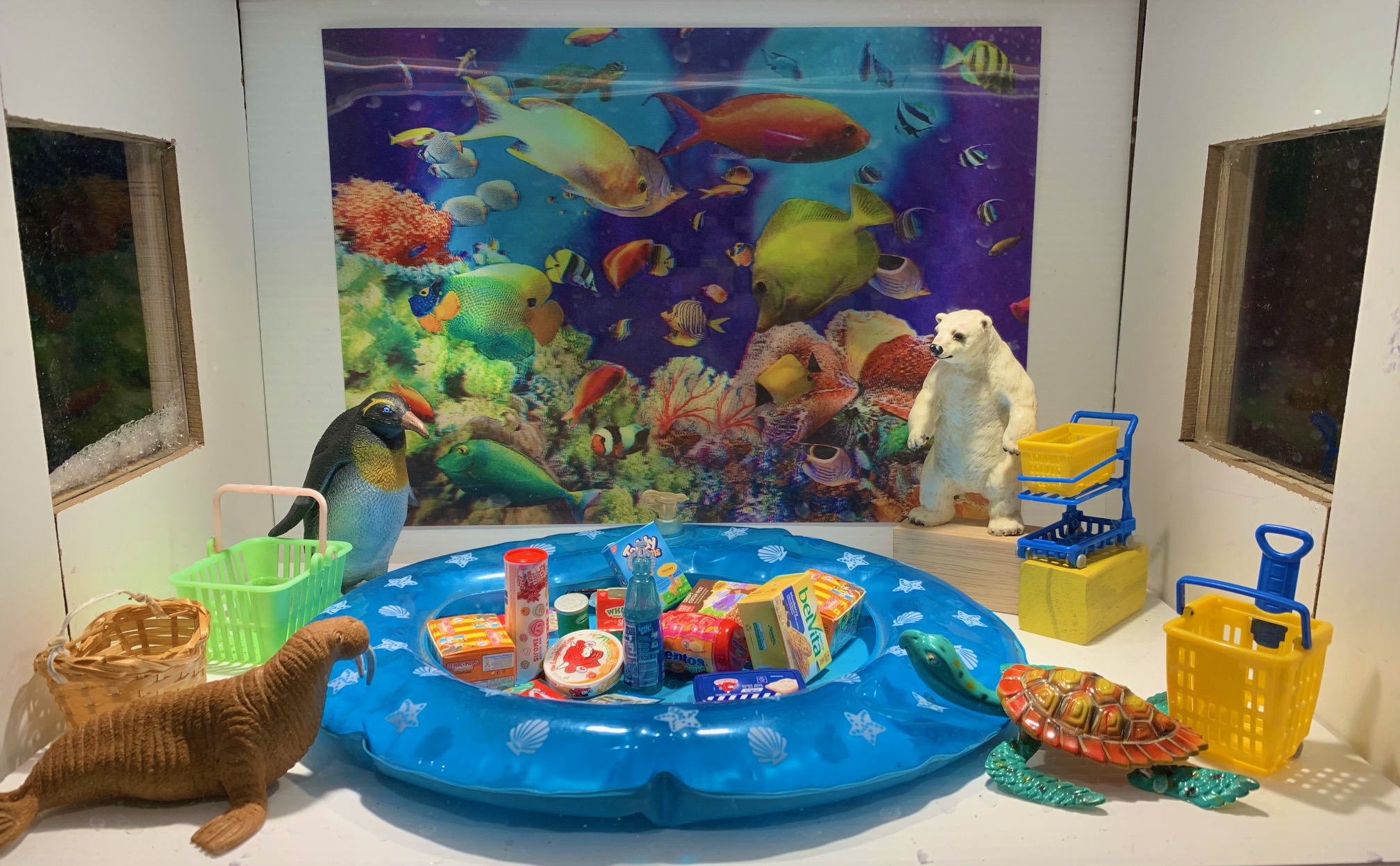
'WHAT'S FOR DINNER?'
This is a very early diorama, but I think one of my most successful ones. It addresses climate change, habitat loss, plastic pollution and food insecurity, all in a colourful and attractive package. Children delight in the use of ”Mini Brands,” currently a popular toy that exemplifies over packaging. The lenticular image in the background changes from fish to fruit when you shift your gaze. We should all be eating more fruit!
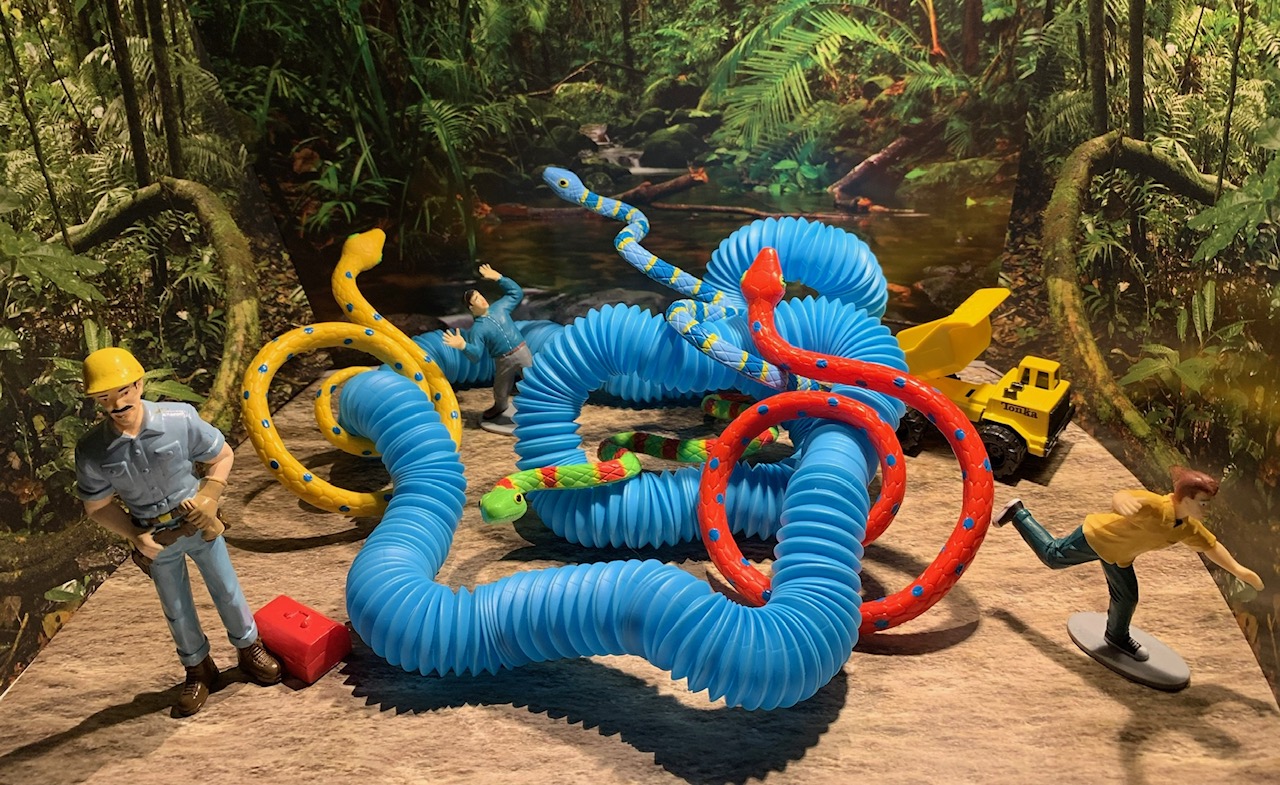
'PROGRESS IS NEVER SMOOTH'
Several possibilities here . . . the blue pipe could represent the pipeline being built or a giant snake with no end. The guy with the hard hat could be a construction worker minding the site or turning his back on the project. Are the snakes fighting back or hopelessly entangled? How are the frightened people involved? I'm always pleased when a diorama invites the viewer to come up with their own story.

'WHO WILL GET THE LAST ICE?'
This diorama features the valuable glass penguin collection that belonged to my late great aunt Mary. I placed them on brightly coloured plastic stadium seating to increase their sense of fragility, but also to add an element of fun to draw kids in. When you shift your gaze over the lenticular background, the image shifts from penguin to polar bear, creating a dreamlike scene. In the foreground: the two animals who are polar opposites are competing, tragically, for the last bit of ice while photographers capture the scene. What is their take on it all? — creating awareness or exploiting vulnerability? Questions like these encourage discussion and challenge kids to think.
THE ARTIST WHO ONCE WAS A CHILD
WHITNEY When you were a kid, did you ever play with dolls or train sets or that sort of thing?
MARTHA I first played with Little Kiddles, wholesome 3-inch high doll children invented in the 1960s with slightly larger than proportionate-scale heads. I resisted playing with Barbie. She was too girlie and all you could do was dress and undress her. I preferred the British “Action Man.” I loved his gear: the flippers, the parachutes. I would race him around in the bathtub or throw him up into the trees.
I also had a doll house made out of a bookshelf that my dad made. I loved it, I should’ve kept it. It had a little red roof and a hole cut in the side for a door. It was very simple. When my mother died and left me an inheritance in 2007, I splurged and bought the biggest, most beautiful doll house I could find, in memory of her. She loved great architecture and beautiful interiors. It’s three storeys tall with electric lights in every room. It reminds me of the Painted Ladies in San Francisco [Victorian and Edwardian houses repainted in three or more colours, starting in the 1960s]. My daughter and I have written two books of photographs and text, with my dollhouse as a central character.
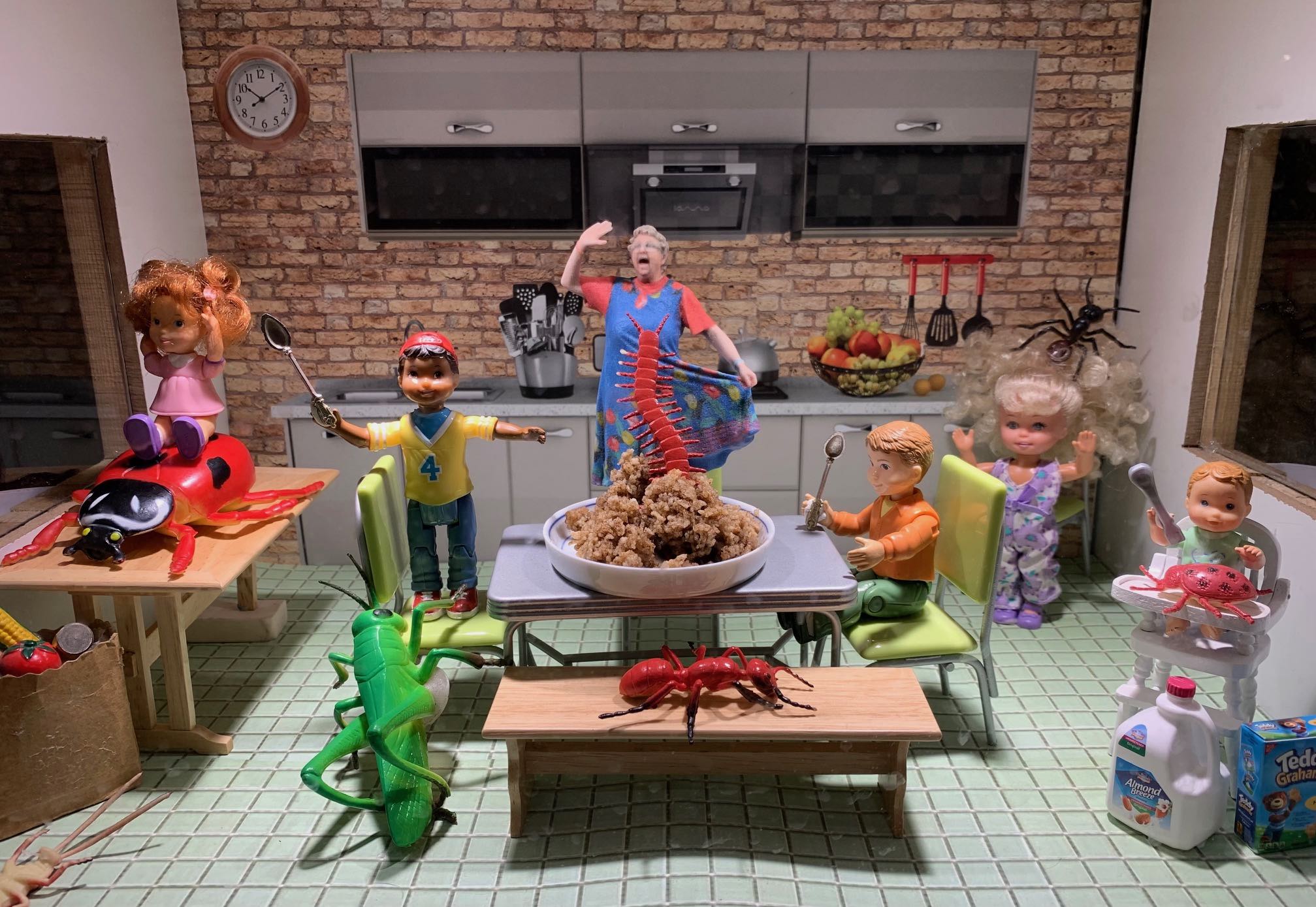
'THE FUTURE OF FOOD'
Kids love this one because of the creepy crawlies, yet the underlying message is more sinister: this is what will happen if (or when?) agriculture goes down. Bugs are part of the staple diet in many developing countries, but I wanted to show them brought right into a classy contemporary kitchen. That’s a miniature 3D printed model of me being greeted by the giant centipede.
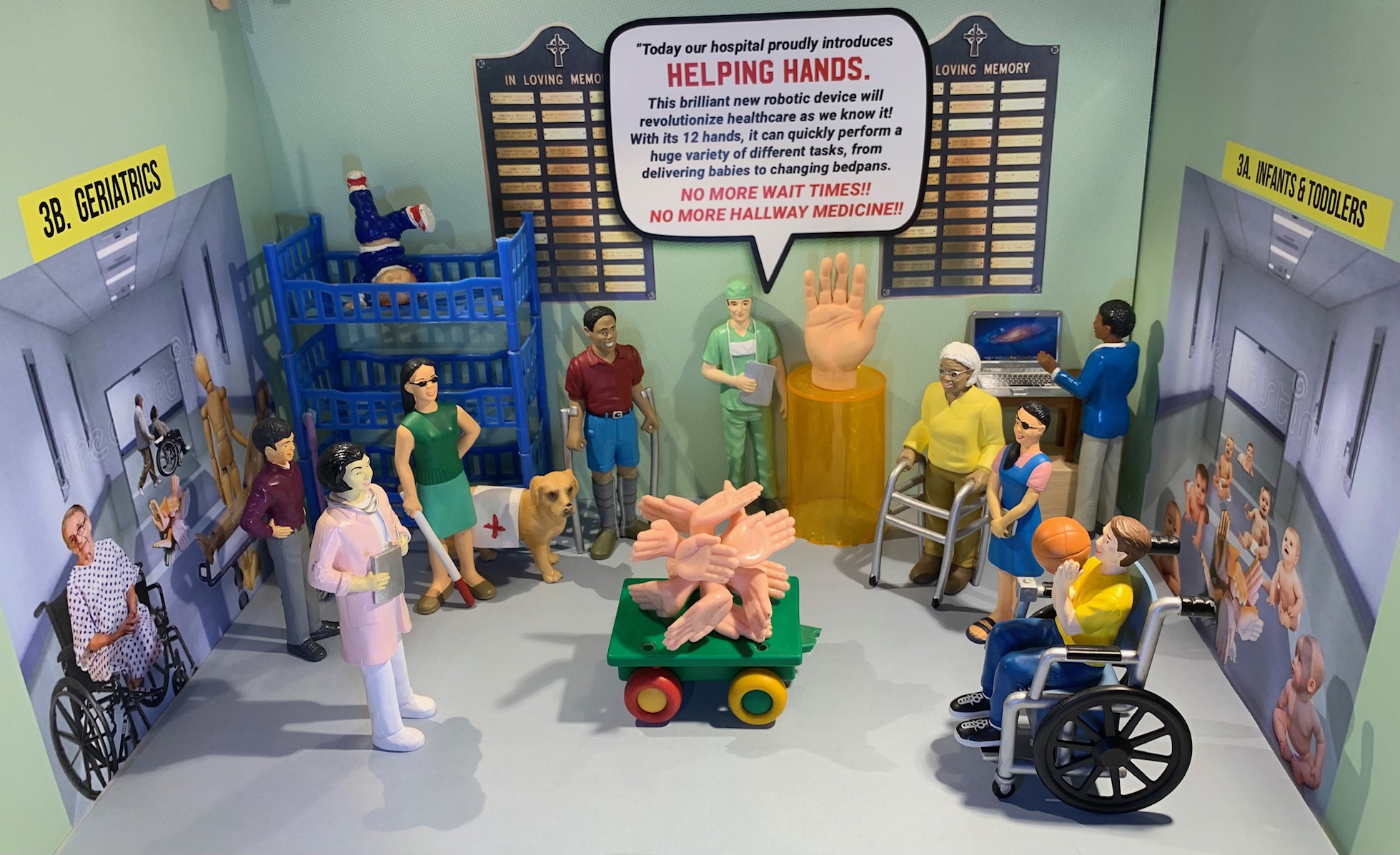
'HELPING HANDS'
I’m poking fun at our current healthcare system in this diorama. The signs of a fractured system are apparent and a solution is being presented: a set of rubber hands (being pawned off as a “robotic device”), which is ludicrous. I’m using a speech bubble for the first time, and the sides of the diorama are more important than ever, extending the perspective down two long grey hallways.
WORK PRACTICE
WHITNEY How do you go about making your dioramas?
MARTHA I give myself a week to make each diorama — with the changeover on Thursdays, depending on the weather. I’m pretty well working on them most of the week. My studio downstairs has both a children’s area where I run a “Fun with Photography” program for kids on the weekend and the area where I create my dioramas. There's a table where I have built three coroplast room boxes, exactly the size of the lightbox, where I can build them, light them, and photograph them to my heart’s content. I usually design my backgrounds on my iPad and get them printed at a copy shop down the street. I got the wonderful, shifting lenticular images, which I use as backgrounds in several of my dioramas, at a tiny tourist shop for $1.50 each.
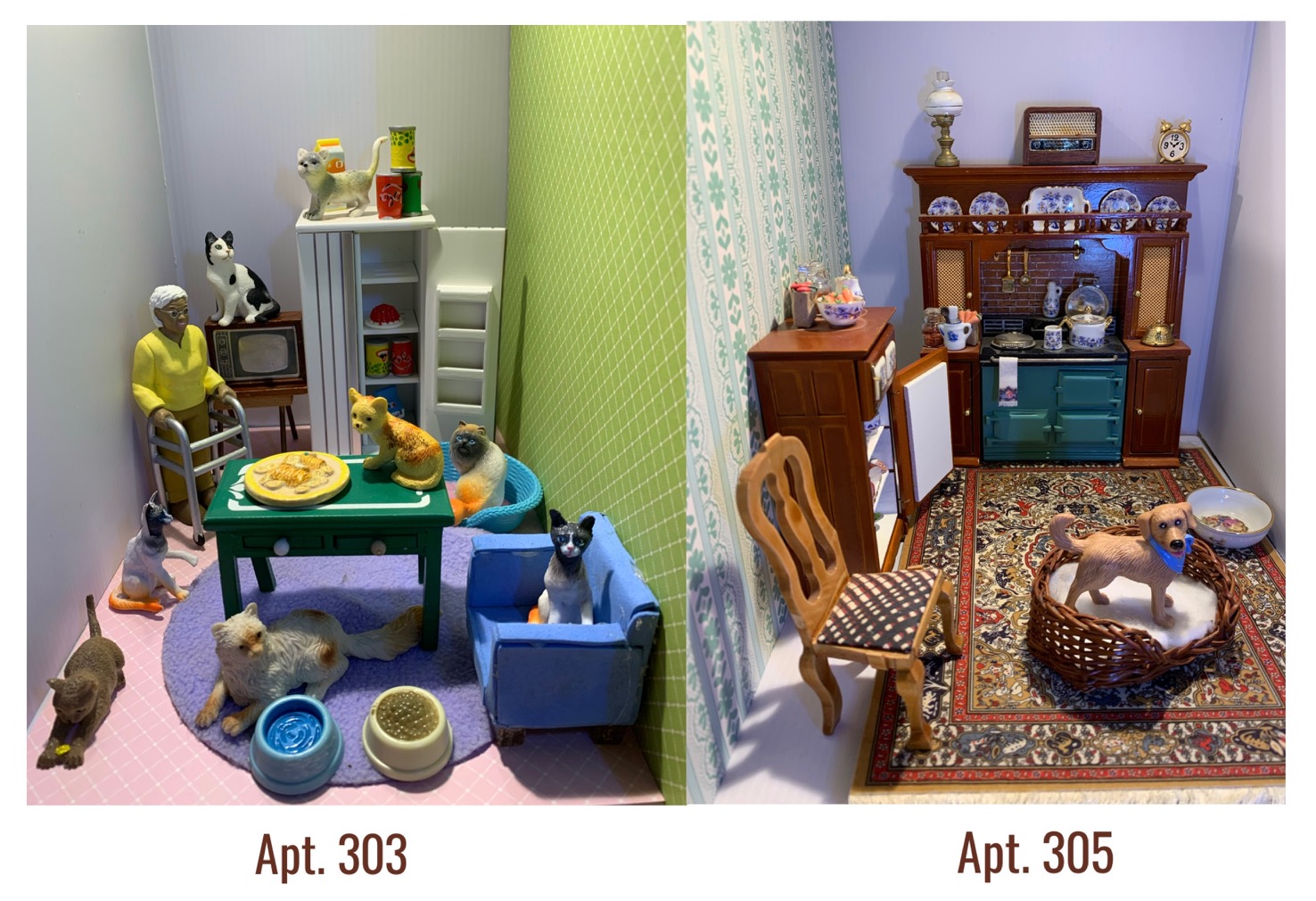
'NEIGHBOURS'
This split-scene diorama is the first one I’ve done. Two extremes are side-by-side. Among other things, I think this one’s about happiness: does wealth create happiness? How does the woman feel in apartment 303? How does the dog feel in apartment 305? What do we require to be happy?

'IF ONLY'
The senior stands on a glittering, mirrored, circular stage. In her imagination, she’s the belle of the ball. Except she didn’t have the same opportunities as the young, active, privileged white women who surround her. In the background, battered suitcases represent memories and belie a life spent moving about. The white cat might be her only real companion.
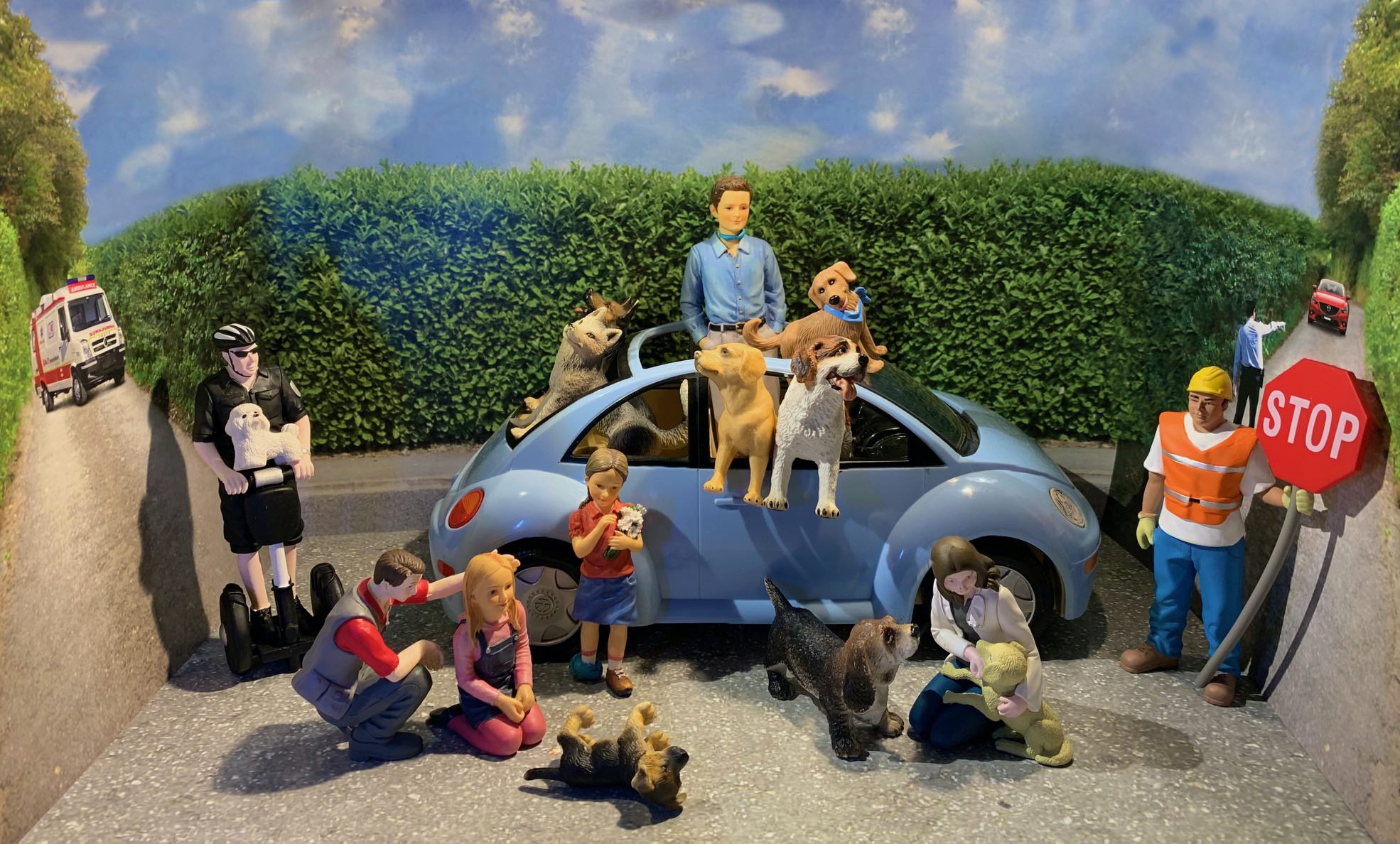
'LOST & FOUND'
As in “Helping Hands”, I extended the sides of the diorama to widen the scene, create perspective, and provide space for more information.
Many questions are hanging in the air around this one. Who are these people? What’s happening with the dogs? Where are they? What are they doing? Everybody will make up their own story. One optimistic little girl commented that the dog lying on the ground “just wants a belly rub.”
OTHER WORK BY MARTHA DAVIS
• Watch Martha's film made of the Pandaland project
2022, 14 minutes.
• Upcoming Exhibition
'Diorama Dramas'
Scotiabank Contact International Photography Festival
The Star Gallery, 918 Bathurst Street, Toronto
May 16-29, Monday to Friday 9am-5pm, Sat. 11-3, Sun. 12-4.
• View Martha Davis' website here.

Comments
What an amazing collection…
What an amazing collection of "life expressions"! They all beg a variety of interpretations and stimulating imaginations. What gifts! Thank you, Martha!
Hi Martha, You really have a…
You really have a great idea here. I hope you are able to display these so lots of people see them. What an imagination you have! Where do you get all these little figurines or do make some of them?
These diodramas are such a…
These diodramas are such a positive initiative ! I could see them being used in many settings. Of course with children in schools and community centres, in hospitals with children, in therapy sessions with all ages, in workshops about diversity, racism, social values and more.
Such an interesting and…
Such an interesting and creative use of the diorama medium! I remember in school we made dioramas out of shoe boxes, usually to display information about animal habitats. They were primitive, but I had fun with them at the time. You’ve taken it to a whole new level! The detail in them is fantastic, and the range of ideas breathtaking. These should be exhibited widely, and not just to children.
Add new comment